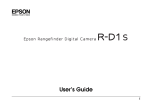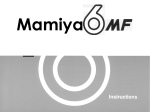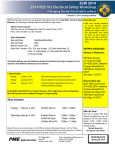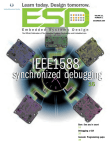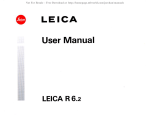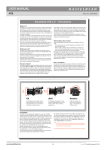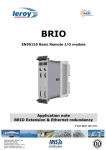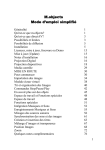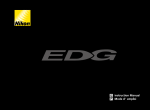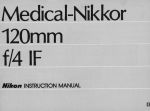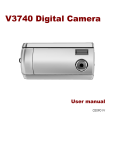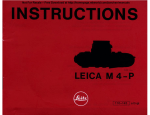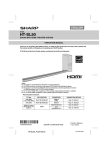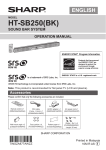Download Leica M6 TTL User's Manual
Transcript
Not For Resale – Free Download at http://www.joe-chan.com/manuals Not For Resale – Free Download at http://www.joe-chan.com/manuals Not For Resale – Free Download at http://www.joe-chan.com/manuals Not For Resale – Free Download at http://www.joe-chan.com/manuals Leica Akademie Dear Customer, Leica not only manufactures high-performance products for everything from observation to reproduction: it offers a special service in the form of the Leica Akademie. For many years, this internationally famous facility has taught photographic expertise in practical seminars and training courses. It meets the needs of keen photographers, both beginners and advanced students, for special training in demanding areas of 35 mm photography, projection, and enlargement. Congratulations on your decision to purchase the LEICA M6 TTL. You have chosen an excellent and unique rangefinder camera. We wish you many years of pleasure and successful photography with your camera. We recommend that you read these instructions first in order to derive full benefit from the photographic possibilities offered by your new camera. Up-to-date, well-equipped seminar rooms are available at our Solms headquarters and at the nearby "Gut Altenberg" for these courses, which are held by experienced instructors, the content of which ranges from general photography to specialised fields of interest. They provide a wealth of practical suggestions, help, and advice. Further information and details of seminars are available from: Leica Camera AG Leica Akademie Oskar Barnack Str. 11 D- 35606 Solms Tel: 06442208421 Fax: 06442 208 425 e-mail: [email protected] 1 Not For Resale – Free Download at http://www.joe-chan.com/manuals Contents Page Leica Academy .............................................................. 1 Foreword ....................................................................... 1 Nomenclature ............................................................. 2/3 Viewfinder displays ........................................................ 3 Fitting the carrying strap ................................................ 4 Power supply ............................................................. 5 Batteries..................................................................... 5 Loading and replacing the batteries ........................... 5 Automatic battery check............................................. 6 Quick-wind lever ............................................................ 7 Shutter release button.................................................... 7 Shutter speed dial .......................................................... 7 Loading the film ............................................................. 8 Opening the camera .................................................. 8 Inserting the film......................................................... 9 Closing the camera .................................................. 10 Transport to the first frame....................................... 10 Setting the film speed............................................... 10 Film rewind and removal .......................................... 11 Fitting the lens ............................................................. 12 Removing the lens ....................................................... 13 LEICA M lens design ................................................... 13 Focusing ring ........................................................... 14 Aperture ring ............................................................ 14 Depth-of-field scale .................................................. 15 Lens hoods .............................................................. 16 Use of older LEICA M lenses ....................................... 16 How to hold the camera correctly................................. 17 Bright-line viewfinder.................................................... 18 Frame selector ......................................................... 20 Rangefinder ................................................................. 22 Coincidence (double image) focusing ...................... 22 Split-image focusing................................................. 22 Exposure metering....................................................... 24 Switching on the exposure meter ............................. 24 Nomenclature 1. 2. 3. 4. 5. 6. 7. Battery compartment cover Lens release button Eyelets for carrying strap Red button for lens alignment Lever for film rewinding release Automatic frame counter Shutter release button with threaded socket for cable release 8. Quick-wind lever for film transport and shutter wind (must be brought in stand-by position when shooting) 9. Rangefinder window 10. Shutter speed dial with clickstops for: • Shutter speeds from 1 to 1/1 000s • " " for 1/50 s synchronising speed for flash operation • "B" for long exposures • "OFF" for switching off the electronics 11. Accessory shoe for flash control with: • Centre contact • Contacts for TTL flash control 12. Bright-line frame illumination window 13. Angled rewind crank 14. Viewfinder window with mirrored strip for LED visibility in bright light 15. Fixed ring with depth-of-field scale 16. Focusing ring 17. Aperture ring 18. Frame preselector 2 Not For Resale – Free Download at http://www.joe-chan.com/manuals Setting the correct shutter speed/ Page aperture combination ........................................... 25 Meter sensitivity ................................................... 26 Low light levels .................................................... 26 General information on exposure metering .......... 26 Switching off the exposure meter......................... 26 Metering diagram.............................................27/29 Metering field ....................................................... 30 Tips for exposure metering .................................. 32 Use of flash.............................................................. 38 Compatible flashguns .......................................... 39 Fitting and connecting the flash unit..................... 39 TTL flash mode.................................................... 40 Settings for TTL flash mode ................................. 40 Flash exposure displays in the viewfinder in TTL and automatic mode ..................................... 40 Flash exposure displays in the viewfinder in manual flash mode .............................................. 41 Flash exposure displays in the viewfinder in strobe mode......................................................... 41 System accessories for the LEICA M6 TTL ............. 42 Interchangeable lenses........................................ 42 Filters................................................................... 42 Eyesight correction lenses ................................... 42 LEICA WINDER M............................................... 43 Bags and cases ................................................... 43 Tips on maintenance of M6 camera and lenses . .44 Alphabetical index ................................................... 45 Technical data ......................................................... 46 Other LEICA products.............................................. 48 Projectors ............................................................ 48 Binoculars............................................................ 48 LEICA Services ....................................................... 49 Information Service.............................................. 49 Customer Service ................................................ 49 LeicaCard ............................................................ 49 3 19. 20. 21. 22. 23. 24. 25. 26. Base plate Base plate catch Viewfinder eyepiece Synchronisation socket for flash units with cable Camera back ISO (ASA/DIN) film speed dial Base plate holding pin Tripod bushing A/, DIN 4503 1/4") Viewfinder displays LEDs-(Light Emitting Diode) for: A Shutter/aperture balance B Flash operation C Bright-line frame for 50 mm and 75 mm (Example) D Metering field for focusing Not For Resale – Free Download at http://www.joe-chan.com/manuals Fitting the carrying strap 4 Not For Resale – Free Download at http://www.joe-chan.com/manuals Batteries Silver oxide button cells Duracell D 357 (10 L 14) Everready EPX 76 Kodak KS 76 Maxell SR 44 National SR 44 Panasonic SR 44 Philips 357 Ray-o-vac 357 Sony SR 44 Ucar EPX 76 Varta V 76 PX Lithium cells Duracell DL 1/3 N Kodak K 58 L Philips CR 1/3 N Ucar 2 L 76 Varta CR 1/3 N Loading and replacing the batteries Power supply The LEICA M6 TTL requires two 1.5 volt silver oxide button cells or one 3 volt lithium cell for the exposure meter and to trigger connected flash units. If the camera is not in use for longer periods of time or if you wish to keep a battery with you as replacement, lithium cells are particularly suitable, as they can be stored for several years with no loss of energy. 5 1. Unscrew the battery compartment cover (1). 2. Wipe any oxidation residue off the cells using a clean cloth. 3. Insert the cells into the holder in the battery compartment cover. Pay attention to the polarity. 4. Now screw the cover together with the cells back into the camera. 5. To remove the batteries, follow the same procedure in reverse. A set of fresh batteries has a life of approximately 8 hours with the exposure meter switched on continuously. Assuming 10second measurements in normal use, one set of batteries therefore supplies sufficient energy for approx. 2900 exposures, i.e. 80 films of 36 exposures each. Not For Resale – Free Download at http://www.joe-chan.com/manuals Automatic battery check • In order to ensure proper battery recycling, take the batteries to a recycling point. • If the camera is not to be used for longer periods, remove the batteries. • Store batteries in a cool and dry place. If the red LED is flickering, i.e. its brightness fluctuates, the batteries should be replaced. If the cells are unable to supply the minimum operating voltage, the LED display disappears. Note: the electrical circuit can be broken by oxidation of the battery surfaces; this will also cause the LEDs to go out. In this case, remove the batteries and clean the battery terminals, camera contacts and battery compartment cover with a clean cloth. Important: • Always replace batteries in full sets. Do not mix batteries of different make or type. • Keep battery contacts clean. • Do not incinerate, recharge, open, dismantle or heat the batteries. • Remove exhausted batteries as soon as possible. Do not dispose of used batteries in normal garbage as they contain environmentally harmful substances. 6 Not For Resale – Free Download at http://www.joe-chan.com/manuals Shutter release button The shutter release button (7) should be pressed softly (not jerkily) until it clicks and the shutter is opened. The shutter release has a threaded socket to accept standard cable releases. Shutter speed dial The size and location of the shutter speed dial of the LEICA M6 TTL are ergonomically perfect: on the one hand, the dial is extremely easy to use and can also be operated with the camera held to the eye. On the other hand it is well protected to prevent it from being switched on or the settings changed accidentally. In addition, its direction of rotation (like that of the aperture ring on the lenses) corresponds to the exposure meter displays in the viewfinder: if the left-hand triangular LED is flashing for example, turning the wheel in the direction of the arrow, i.e. to the right, will lead to the slower shutter speed required. Quick-wind lever The quick-wind lever (8) is used to advance the film, to cock the shutter and to automatically advance the frame counter. For rapid sequences, the user can put the lever into a "ready position". The shutter speed dial (10) of the LEICA M6 TTL is used to select the shutter speeds - from 1/1000s to 1s - and also the synchronising speed " " for flash operation (1/50 s) and "B" for long exposures. 7 Not For Resale – Free Download at http://www.joe-chan.com/manuals When the dial is set to "B", the shutter remains open until the shutter release button is released. The "OFF" position is located between "B" and the end of the scale. When the dial is turned to this position, the exposure meter is switched off. The speed selector dial engages positively at all engraved speeds. Intermediate speeds cannot be selected. For details on correct exposure, see the "Exposure metering" section on page 24. Loading the film Always start by making sure that there is no film in the camera by turning the rewind crank (13) gently in the direction of the arrow. Any resistance indicates that a film is already loaded; see rewinding instructions on page 11. Begin by actuating the wind lever and pressing the release button. Hold the camera in your left hand with the base plate pointing upwards. Opening the camera 1. Raise the latch (20) on the base plate (19). 2. Turn the latch to the left. 3. Remove the base plate. 4. Fold the back (23) out towards the rear. 8 Not For Resale – Free Download at http://www.joe-chan.com/manuals Inserting the film 5. Hold the film cartridge in the right hand and insert it about half-way into the empty chamber. 6. Take the film leader and pull it into the takeup chamber spool (28), as shown in the dia- gram (27) of the camera housing. 7. Using your fingers push the cartridge and the film leader carefully into the camera. Note: the end of the film must be tapered, as is the case with made-up films. Under ordinary conditions it does not matter if the film end projects through the three-post assembly. In extremely cold, dry weather, however, the end may break off, and the drawing should then be followed exactly. Note: with the camera back open, three goldplated electrical contacts (29) are visible on the back and in the camera housing. These contacts are corrosion-free, and relatively insensitive to dirt and dust. Special care of these contacts is not necessary. Important Do not check correct loading when the camera is open. The base plate is designed such that it guides the film into the correct position when attached to the camera. When loading a new film, however, ensure nevertheless that the contacts are kept clean and dry. 9 Not For Resale – Free Download at http://www.joe-chan.com/manuals arrow. The film is properly transported when the rewind crank turns backwards when the quick-wind lever is operated again. 14. Finally, press the shutter release button again and cock the shutter for the third time. The frame counter (6) now reads 1 and the camera is ready to shoot. Setting the film speed Closing the camera 8. Replace the camera back. 9. Hook the base plate over the external mounting post on the camera body (25). 10. Fold the base plate back into its normal position, ensuring that the camera back is in full contact so that the base plate envelops it. 11. Lock the back using the base plate catch. The dial for setting the exposure meter to the film speed (24) can be used to set values from ISO 6/9° to ISO 6400/39° (ASA 6/9 DIN to ASA 6400/39 DIN; the ISO designation is that generally used internationally). To set the film speed: 1. Press the centre of the dial down and turn it until the two triangles are aligned opposite the desired film speeds (DIN above, ASA below). 2. When released, the disc will engage and spring back flush with the surrounding ring if it has been set properly. Transport of the film to the first frame 12. Advance the film to the next frame by means of the quick-wind lever, and release the shutter. 13. Gently pull the film taut by turning the rewind crank (13) in the direction of the 10 Not For Resale – Free Download at http://www.joe-chan.com/manuals The following settings are possible: Scale 6/9° 12/12° 25/15° 50/18° 100/21° - Film speed ISO (ASA/DIN) 6/9° 8/10° 10/11° 12/12° 16/13° 20/14° 25/15° 32/16° 40/17° 50/18° 64/19° 80/20° 100/21° 125/22° 160/23° Scale 200/24° 400/27° 800/30° 1600/33° 3200/36° 6400/39° Film speed ISO (ASA/DIN) 200/24° 250/25° 320/26° 400/27° 500/28° 640/29° 800/30° 1000/31° 1250/32° 1600/33° 2000/34° 2500/35° 3200/36° 4000/37° 5000/38° 6400/39° Film rewind and removal When the last frame has been exposed, the quick-wind lever can no longer be operated. Before the film can be removed, it must be wound back into the cartridge. 1. Turn rewind lever (5) to "R". 2. Swing out the lever for the rewind crank. 3. Turn the lever clockwise (in the direction of the arrow) until the film is freed from the take-up spool; slight resistance will be felt at this point. 11 Not For Resale – Free Download at http://www.joe-chan.com/manuals 4. Now open the base plate. 5. Open the camera back. 6. Remove the film cartridge. When the film is not fixed to the cartridge core, for example when bulk film is used, it may become separated from the core if the advance lever is operated forcefully after the last frame has been exposed. In this case, proceed as follows: 1. Remove the base plate of the camera in a completely dark room. 2. Hold the camera with the base plate open and facing downwards. 3. Slowly operate the quick-wind lever several times until the film protrudes far enough to be grasped and pulled out. If necessary, gently hit the camera against the palm of your hand. Fitting the lens to the camera 1. Hold the lens by the fixed ring (15). 2. Align the red lens alignment button (4) with the lens release button (2) on the camera body. 3. Fit the lens in this position, ensuring that it is perpendicular to the front of the camera 4. Turn the lens slightly to the right to latch it audibly and perceptibly into place. 12 Not For Resale – Free Download at http://www.joe-chan.com/manuals Removing the lens Design of the LEICA M lenses 1. Hold the lens by the fixed ring (15) 2. Depress the lens release button (2) on the camera body 3. Turn the lens anticlockwise until the lens alignment button (4) lines up with the lens release button 4. Remove the lens, keeping it perpendicular to the camera body. The LEICA M lenses are equipped with a fixed ring with depth-of-field scale (15), a rotatable focusing ring (16) and an aperture setting ring (17). Note: When the camera is loaded with film, change the lens in the shade of your body, as direct sunlight may otherwise penetrate the shutter. 13 Not For Resale – Free Download at http://www.joe-chan.com/manuals Like the shutter speed dial, the aperture ring engages perceptibly at each full stop (and for most lenses also at half-stops). With a little practice, you will also be able to set the apertures in the dark. Like the shutter speed dial, the aperture ring moves in the same direction as the exposure meter displays in the viewfinder: When the left triangular LED comes on, for example, turning the dial in the direction of the arrow, i.e. to the right, causes the slower shutter speed required to be set. Focusing ring The focusing ring (16) shows the distance set and, in conjunction with the scale (15), the depth-of-field range. For details on focusing, see the "Rangefinder" section on page 22. For further details on setting the correct exposure, see the "Exposure metering" section on page 24. Aperture ring (17) The aperture values are standardised worldwide. They are selected such that the amount of light reaching the film is always halved when the lens is stopped down between two successive apertures (stops). One stop corresponds to one value on the shutter speed dial (10). 14 Not For Resale – Free Download at http://www.joe-chan.com/manuals indicates the range of sharpness at the set focus distance. For example, using the LEICA SUMMILUX-M f/1.4/50 mm lens focused at 5 metres, the depth-of-field at f/4 ranges from approximately 4 to 8 metres. Stopping down to f/11 at the same focusing distance, however, increases the range to 3 - 20 metres. Depth-of-field scale The plane which is rendered sharpest is the plane, parallel to the film, upon which the lens is focused. The optimum sharpness decreases progressively in front of and behind this plane such that a certain range exists within which the image is, to the eye, rendered sharply. This range is termed the depth of field. It is dependent on the focus setting, the focal length of the lens (the two values together determine the reproduction scale) and the aperture. Stopping down, i.e. selection of a larger f-number, increases depth-of-field, whilst widening the aperture, i.e. selection of a smaller f-number, decreases it. The depth-offield scale in conjunction with the focusing ring 15 Not For Resale – Free Download at http://www.joe-chan.com/manuals Use of older LEICA M lenses All LEICA M lenses can be used without restriction. However, the exposure metering system does not function with the following types: HOLOGON f/8/15mm, SUPER-ANGULON-M f/4/21 mm, SUPER-ANGULON Mf/3.4/21 mm, ELMARIT-M f/2.8/28 mm up to Serial No. 231 4921. Lens hoods Each LEICA M lens is supplied with a lens hood the design of which is geared to the lens. Several lenses have built-in telescopic lens hoods. The lens hoods should always be used as they provide both shade from stray light and glare and protection against rain drops or fingerprints. The following lens must be set to infinity during fitting/removal: SUMMICRON with close focusing f/2/50 mm 16 Not For Resale – Free Download at http://www.joe-chan.com/manuals How to hold the camera correctly In order to achieve sharp, well-focused photographs, the camera must be held as steadily and comfortably as possible. Hold the LEICA M6 TTL in a suitable, safe "three-point holding position" as follows: hold the camera with your right hand with your index finger on the release button and your thumb pushed behind the quick-wind lever in its operating, standby position. In addition, support the lens from below with your left hand, with which you can refocus quickly at any time, and press the camera against your forehead. For vertical pictures, turn the LEICA M6 TTL to the left and keep your hands in the same position as for horizontal shots. You can however also rotate the camera to the right. In this case, it may be advantageous to release the shutter using your thumb. Note: We recommend the practical handgrip M (accessory) to enable you to hold the LEICA M6 TTL and to carry it securely whilst keeping your hands free (order No. 14 405). 17 Not For Resale – Free Download at http://www.joe-chan.com/manuals Bright-line viewfinder The bright-line viewfinder of the LEICA M6 TTL comprises not only a high-quality, large, bright and high-contrast viewfinder showing every detail which will appear on the final picture, but also a highly accurate lens-coupled rangefinder. The size of the frame corresponds to an image field of 23 x 35 mm (slide format) at the closest focusing distance for each lens. At longer distances, the image will contain a somewhat larger subject field than that shown within the bright-line frame. The frames are coupled to the focusing mechanism such that parallax errors (the distance between lens and viewfinder axes) are automatically compensated for as the lens is focused, and the bright-line frame is the same as the film image in the entire range from 0.7 m to ∞. There are two LEICA M6 TTL models with different versions of this viewfinder, which differ in their magnification: responding bright-line frame is automatically reflected into the viewfinder in the combinations 28 + 90 mm, 35 + 135 mm, and 50 + 75 mm. When the LEICA M6 TTL is used with 0.85x viewfinder magnification, a corresponding five frames are reflected into the viewfinder for the focal lengths from 35 mm upwards. The centre of the viewfinder contains a somewhat brighter rectangle: this is the LEICA rangefinder. All lenses with focal lengths from 21 to 135 mm couple to the rangefinder when attached to the LEICA M6 TTL. With the exposure meter switched on, the lower edge of the viewfinder also displays the LEDs of the exposure meter or the LED flash symbol. For details on distance and exposure metering and flash operation, refer to the corresponding section on pages 22, 24 and 38. When lenses with focal lengths of 28 (from serial No. 2411001 onwards), 35, 50, 75, 90 and 135 mm are used on the LEICA M6 TTL with 0.72x viewfinder magnification, the cor18 Not For Resale – Free Download at http://www.joe-chan.com/manuals LED for flash operation Bright-line frame 35 mm Bright-line frame 135 mm LED’s for shutter/aperture balance Metering field for focusing 19 Not For Resale – Free Download at http://www.joe-chan.com/manuals Frame preselector The frame preselector lever (18) extends the possibilities of the LEICA M6 TTL viewfinder. Using this integrated universal viewfinder, you can view frames which do not correspond to the lens which is actually fitted. Thus, you can test whether the composition would be better served by a different focal length. When the lever is pointing outwards, i.e. away from the lens, the frames for the 35 and 135 mm focal lengths are displayed. When the lever is in its vertical, central position, the frames for the 50 and 75 mm focal lengths are shown. When the lever is pointing inwards, i.e. towards the lens, the LEICA M6 TTL viewfinder with 0.72x magnification displays the frames for the 28 and 90 mm focal lengths, and the 0.85x magnification viewfinder only shows the bright-line frame for the 90 mm focal length. 20 Not For Resale – Free Download at http://www.joe-chan.com/manuals *not for LEICA M6 TTL 0.85 21 Not For Resale – Free Download at http://www.joe-chan.com/manuals Rangefinder Coincidence (double image) focusing Thanks to its high effective base line value, the rangefinder of the two LEICA M6 TTL models permits very precise control. This is particularly advantageous when wide-angle lenses, which provide a relatively large depth-of-field, are used. The larger magnification of the 0.85-fold viewfinder with its longer base line leads to even higher accuracy: In most cases, and particularly for pictures of people, the coincidence or double-image method is preferable because it requires no straight lines in the subject. Simply cover the most important part of the subject with the rangefinder field, turn the focusing ring of the lens until the double image merges to one, and recompose (if necessary) to make the exposure. Mechanical base line x Viewfinder (distance between magnification the optical axes of the viewfinder and the rangefinder window = Effective base line Split-image focusing LEICA M6 TTL with 0.72x viewfinder 69.25 mm x 0.72 Approx. = 49.9 mm LEICA M6 TTL with 0.85x viewfinder 69.25 mm x 0.85 Approx. = 58.9 mm The rangefinder field is the bright rectangle in the centre of the viewfinder field. If you cover up the large viewfinder window (14), only the bright-line frames and the rangefinder field remain visible. The bright, sharply defined rangefinder field permits the use of either coincidence or split-image rangefinder focusing. For pictures of buildings or other subjects containing straight vertical lines, position the rangefinder field such that it is intersected by a line. Now turn the focusing ring of the lens until one continuous line is formed. In practical use, it may be advantageous to combine both methods. 22 Not For Resale – Free Download at http://www.joe-chan.com/manuals Double image = out of focus Broken line = out of focus Coincident image = in focus Continuous line = in focus 23 Not For Resale – Free Download at http://www.joe-chan.com/manuals The unevenness of the white is not a result of poor manufacturing tolerances, but is due to the fact that a thick, complete coating cannot be applied to the rubberised cloth shutter curtain without the shutter performance being impaired. The irregular structure of the metering spot in no way affects the meter reading. Exposure metering The LEICA M6 TTL meters for exposure under ambient light through the lens at the working aperture. The reading is selective, by light reflected from a bright metering field onto a photo diode (arrow). This diode is located behind a collecting lens to the left of and above the shutter. The metering field (diameter: 12 mm, i.e. approx. 13% of the negatives size) is situated in the centre of the first shutter curtain. The lens f-stop and shutter speed for correct exposure are indicated by the appearance of the light balance ( ) in the viewfinder: the exposure is correct when only the round LED in the middle comes on. Switching on the exposure meter The exposure meter is switched on by light pressure on the shutter release button (7), providing that the shutter is cocked and the shutter speed dial is not set to "B" or "OFF". When one of the two triangular LEDs or the central round LED comes on, the exposure meter is ready for operation. 24 Not For Resale – Free Download at http://www.joe-chan.com/manuals If finger pressure is released without the shutter being depressed, the exposure meter remains switched on for approx. 14 s and the corresponding LED(s) remain on. When the shutter is activated, the meter switches off and the LEDs in the viewfinder go out. When the shutter is not cocked, or the shutter speed dial is set to "B" or "OFF", the exposure meter remains switched off. Then: 1. Switch on the exposure meter 2. Turn the shutter speed dial and/or the aperture ring on the lens in the direction indicated by the flashing LED until only the round LED comes on. In addition to the direction of rotation of both shutter speed dial and lens aperture ring required for correct exposure, the three LEDs of the light balance also indicate over-, underand correct exposure as follows: Note: at very low levels of luminance, i.e. at the threshold of the light metering range, the LEDs may take approx. 0.5 s to come on. Underexposure by at least one f-stop; turn lens aperture ring clockwise. Underexposure by half an f/stop; turn lens aperture ring clockwise. Correct exposure If the luminance levels fall below the working range of the exposure meter, the left-hand triangular LED flashes. Overexposure by half an f/stop; turn lens aperture ring anticlockwise. Overexposure by at least one stop; turn lens aperture ring anticlockwise. Setting shutter speed/lens aperture combinations for correct exposure For correct exposure metering, the shutter must be cocked and the shutter speed dial must be set at a marked speed. 25 Not For Resale – Free Download at http://www.joe-chan.com/manuals Meter sensitivity 2 The light metering range begins at 0.03 cd/m . The working range at ISO 100/21° extends from -2 to 20 EV (exposure value), i.e. from 4 s (shutter speed dial position "B") at f/1 to 1/1000s at f/32 (see also diagram on page 29). Very low light levels Should the light level fall below the range of the exposure meter, the left triangular LED flashes. Since the meter uses the working aperture, the LEDs may also flash when the lens is stopped down. The exposure meter remains on for approximately 12 seconds after finger pressure is removed from the shutter release button, even if the light level is below the threshold sensitivity level. If the light level improves during this time (e.g. if the composition is changed or the aperture opened), the LEDs stop flashing and come on permanently. General information on exposure metering Most scenes contain an even distribution of bright and dark subject details and reflect an average of 18% of the light falling on them. This value of 18% corresponds to an average grey tone to which exposure meters are calibrated. Very bright subjects, such as snowladen winter scenes, sandy beaches, whitewashed walls or a white wedding gown, reflect more light toward the exposure meter, tending to result in underexposure. Predominantly dark subjects such as a black steam locomotive, dark grey slate roofs, and navy-blue uniforms reflect much less light, and meters tend to overexpose. To achieve correct exposures in these cases, the measured values must be corrected, unless exposure is measured selectively by inclusion of only a portion containing a representative sampling of dark and light subject details. You would for example meter on the bride's face and not on her white gown. A landscape shot with a wideangle lens should be metered with the LEICA M6 TTL pointing downward to exclude the bright sky. When no such metering alternative is available, a compensation factor of 2x or 4x can be 26 Not For Resale – Free Download at http://www.joe-chan.com/manuals used, the lens aperture can be opened by one or two f-stops, or the shutter speed increased. White snow under a clear sky with bright sunlight often calls for an exposure increase of 4x, i.e. instead of the specified shutter speed of 1/1000 s and f/8, use 1/250 s and f/8 or 1/1000 s and f/4. When photographing less bright subjects such as a sandy beach, a compensation factor of 2 is sufficient. The reverse is the case for dark subjects. Note the tips below on exposure metering. Switching off the exposure meter If the camera is stored in a bag or left unused for some time, the shutter speed dial should be set to "OFF". The exposure meter is then switched off. Metering diagram Data on the metering range of the exposure meter can be found on the right-hand side of the diagram. Data on the working range of the focal-plane shutter and lenses can be seen on the left. The exposure values (EV) are shown in the middle. The metering range of the exposure meter is indicated on the right-hand side of the diagram, in cd/m2 (candela per square metre). The ISO film speed values (Sv) are shown at the top of the diagram. The different exposure times in seconds (Tv=Time value) are shown on the left-hand side of the diagram. 27 Not For Resale – Free Download at http://www.joe-chan.com/manuals The working range of the LEICA M6 TTL shutter is indicated schematically by the hatched vertical column at the far left-hand side of the drawing, "B" representing the unrestricted upper end. The aperture values (Av) are shown on the lower left-hand side. Example A shows the correlation between the film speed, luminance (brightness), exposure and aperture. First follow the vertical line from the film speed (ISO 100/21°) down to the intersection on the horizontal line representing the corresponding luminance. In example A, this is 4000 cd/m2, i.e. a typical value for bright sunlight. The line now runs diagonally to the vertical line indicating the aperture (11), and from there horizontally to the required exposure (1/250 s). In the course of this diagonal, the exposure value (15) can also be read off. Example B shows that in candlelight and with a film speed of ISO 400/27° (1 cd/m2), photographs should be taken with an aperture of f/1.4 and a shutter speed of 1/15s. An aperture of f/11, for example, can no longer be used as the corresponding shutter speed of 4 s is not available on the shutter speed dial. As the slowest shutter speed available on the dial is only 1 s, exact metering is also no longer possible. The correct shutter speed can therefore be obtained only by conversion or from this diagram. 28 Not For Resale – Free Download at http://www.joe-chan.com/manuals Metering diagram 29 LEICA M6 TTL Viewfinder magnification 0.72 Not For Resale – Free Download at http://www.joe-chan.com/manuals Metering fields The metering field covers approx. 23% of the viewfinder image for the lens being used. LEICA M6 TTL Viewfinder magnification 0.85 However, the following reference value applies to all lens focal lengths: The diameter of the circular metering field is approx. 2/3 of the short side of the applic-able bright-line frame. This also applies to lenses with viewfinder attachments, such as the LEICA ELMARIT-M f/2.8/135mm. 30 24 mm 21 mm 24 mm 21 mm Not For Resale – Free Download at http://www.joe-chan.com/manuals 90 mm 135 mm 75 mm 28 mm 35 mm 50 mm 90 mm 135 mm 75 mm 28 mm 35 mm 50 mm 31 Not For Resale – Free Download at http://www.joe-chan.com/manuals Tips for exposure metering Landscapes, close-ups or portraits, in the living room, at the airport or at parties - the majority of subjects contain many bright and dark details. Therefore, in general, exposure metering is not a problem. When the camera is tilted a little or turned to the left or right, the exposure value remains unchan- ged with selective metering. However, if a landscape scene containing many white clouds is photographed using a wide-angle lens or if the exposure meter is influenced by very bright lamps in a Bavarian beer tent, for example, the camera should be turned towards an area containing no particular bright or dark details. To meter the exposure in the beer tent, the lens was pointed slightly downwards and to the left towards the lower left-hand corner of the picture to prevent the light source directly above the head of the person forming the subject from influencing the exposure reading. In most cases, the photographer looks through the viewfinder whilst moving the camera in order to find the right framing - even for snapshots. The photographer can determine at the same time whether there is a sufficiently even distribution of dark and light details. 32 Not For Resale – Free Download at http://www.joe-chan.com/manuals 33 Not For Resale – Free Download at http://www.joe-chan.com/manuals A easily identified detail in the frame is also necessary for focusing. If this detail does not happen to be in the centre of an interesting picture area, the camera again has to be moved; the dark/light distribution can of course be checked at the same time. The two pictures above were taken in this way. Left: focusing and exposure metering on the boy on the right in the left-hand window - the camera is returned to the desired picture area - considerable change in exposure value, as the exposure meter now covers predominantly white details - move the camera therefore to the left and point the lens down for renewed exposure metering (metering field of the exposure meter is partially outside the subject area) - return to the original subject area shoot. 34 Not For Resale – Free Download at http://www.joe-chan.com/manuals On the bright beach of Acapulco the exposure value was determined by moving the camera to the right and metering outside the range of the subject area. The area which was metered contained reed huts, palm trees, deckchairs and people, i.e. an even distribution of light and dark details. Opening the aperture by two stops corrects the exposure value for purely white details, as does multiplying the shutter speed by 4 (e.g. 1/125 s instead of 1/500 s). For light-coloured details such as sand, it is sufficient to open the aperture by one stop or double the shutter speed. If such substitute measurements are not possible, exposure metering should be carried out on the light details, for example, the light sand on the beach or in the desert, the whitewashed walls in a Greek village or the snow on the run of a ski slope, and the value then corrected accordingly. In sunny snowscapes the correct exposure for the areas of sunlight can be determined by metering in the shade. In this case no correction need be made. For photographs of spotlit subjects, when many details of the subject are in the shadow, or for predominantly dark subjects such as steam engines or black fields of lava, small portions of the picture area with a good dis35 Not For Resale – Free Download at http://www.joe-chan.com/manuals tribution of light and dark details can usually be found which can be metered using spot metering. In this picture taken at the ballet, the metered area was at the far right, partly outside the picture area. If suitable areas are not available, the dark details must be metered and a correction made, resulting in a smaller aperture or faster shutter speed. Stopping down by half a stop (in extreme cases a whole stop) is sufficient. If there is considerable contrast between light and dark parts of the image, the exposure latitude of the films ceases to be sufficient to register the full tonal range of the subject in both the "light" and the "shade". The photographer must decide where he wishes to retain the greatest detail. For example, a person can appear as a black silhouette (under-exposed) in front of a correctly exposed landscape, or correctly exposed in front of a "burnt-out" background (overexposed). A reading from "light" and "shadow" and the resulting average exposure usually leads to unsatisfactory results because delicate differences in brightness are lost in both the light and the dark areas. 36 Not For Resale – Free Download at http://www.joe-chan.com/manuals The landscape shot was taken following metering in the lower right-hand part of the picture (shadow of the tree on the grass and the horse). For fast-moving subjects, there is often no time for exposure metering. In such cases, exposure metering is performed in advance. In this example, the top left-hand corner was metered, as the tape bordering the racetrack provided light and dark details. Deliberate over- or underexposure often enhances the character of a picture and can be used as a good compositional aid. In this landscape shot, the fir trees and mountain ridges on the left of the picture (without the sky) were metered for the exposure, and the value was then reduced by two stops. 37 Not For Resale – Free Download at http://www.joe-chan.com/manuals Use of flash In addition to the photocell for ambient light, the LEICA M6 TTL is equipped with a second photocell for flash (arrow). This silicon photocell, located on the right below the shutter, enables the camera to measure the light emitted by the flash through the lens, at the working aperture. Through-the-lens metering on the LEICA M6 TTL is centre weighted and integral. flash was specially designed for the LEICA M6 TTL. Important In order to trigger and control the flash units connected by means of the accessory shoe or the coaxial contact (x), the LEICA M6 TTL must be loaded with batteries and the exposure meter must be switched on by lightly pressing the shutter release button. The camera can only control the flash light itself if flash units are used which are compatible with SCA 3000 and have an SCA 3501 adapter, or if the LEICA SF20 flash unit (order No. 14414) is mounted on the camera. This 38 Not For Resale – Free Download at http://www.joe-chan.com/manuals modern thyristor-controlled electronic flash units. Compatible flash units Thanks to its compact dimensions and its dedicated design, the LEICA SF20 is particularly suitable for use with the LEICA M6 TTL. It is very simple to use, as it is equipped with an integrated adapter foot with additional control and signal contacts for automatic transfer of a range of data and settings. In addition, it features a number of additional functions of interest. Fitting and connecting the flash unit When mounting a flash unit on the hotshoe of the LEICA M6 TTL, ensure that the adapter foot of the flash unit is fully inserted and firmly secured by means of the tightening nut, if available. This is especially important in the case of flash units with additional control and signal contacts, as movements of the flash unit within the adapter foot may lead to the contact being broken and consequently to malfunctions. The coaxial contact (x,22) for connecting flash units with cable connection is located below the accessory shoe at the back of the camera. Note: the camera and flash unit must both be switched off before the flash is fitted. However, the photographer can also fit any other proprietary flash unit, provided they are equipped with standard sockets, and also oncamera flash units with standardised adapter foot. These flash units are fired via the centre contact (x,11). We recommend the use of 39 Not For Resale – Free Download at http://www.joe-chan.com/manuals TTL flash mode This mode is available with the LEICA SF20 and any other SCA 3000 flash unit equipped with the SCA adapter 3501. As soon as the requisite quantity of light has been emitted, the camera electronics of the LEICA M6 TTL transmit a "stop" signal to the flash unit, which immediately interrupts light output. This flash mode offers the advantage that all factors influencing exposure of the film (e.g. filters and aperture changes) are automatically taken into account. In addition, the LEICA M6 TTL transfers the film speed set on the camera to the flash unit. 2. Set the desired aperture or that required for the subject-to-camera distance. 3. Prior to any flash exposure, switch on the exposure meter by lightly pressing the shutter release button. If the release button is pressed down completely and the exposure meter remains switched off, the flash unit may not be fired. Note: since the aperture selected on the LEICA M6 TTL is not transferred to the flash, it must be set manually on the flash unit to enable the range to be read off on the latter, if the flash has such a display. Flash units equipped with the corresponding displays can thus automatically adjust their range settings. The film speed setting cannot be influenced by means of the flash unit. Settings for the TTL flash mode After switching on the flash unit and setting it to "TTL", proceed as follows: 1. Turn the shutter speed dial of the LEICA M6 TTL to the flash synchronising speed " " (1/50 s) or select a slower shutter speed (or "B") for special effects. 40 Not For Resale – Free Download at http://www.joe-chan.com/manuals Flash exposure displays in the viewfinder in TTL and automatic flash mode with the flash unit SF20 or flash units equipped with the SCA 3501 adapter In the viewfinder of the LEICA M6 TTL, an LED in the shape of a flash (3) indicates the different modes: • • • • • • is not displayed even though the flash is switched on: The shutter speed set on the camera is faster than 1/50 s flashes slowly (at 2 Hz) before the shutter is released: The flash unit is not yet operational. flashes before the exposure The flash is operational. continues to flash after the exposure: Flash exposure was correct, flash remains operational. flashes rapidly after the exposure (at 4 Hz) Flash exposure was correct, but flash is recycling. does not flash following the exposure: Underexposure, for example due to an aperture too small for the subject Flash exposure displays in the viewfinder in manual flash mode • is not displayed even though the flash is switched on: The shutter speed set on the camera is faster than 1/50 s • flashes slowly (at 2 Hz) before the shutter is released: The flash unit is not yet operational. • flashes before the exposure The flash is operational. Flash exposure displays in the viewfinder in stroboscope flash mode • is not displayed even though the flash is switched on: The shutter speed set on the camera is too fast for the number of flashes set on the flash unit • flashes slowly (at 2 Hz) before the shutter is released: The flash unit is not yet operational. • flashes before the exposure: The flash is operational. Note: for details on flash operation, particularly with other, non-TTL-compatible flash units, and information on the different modes of the flash units, refer to the instruction sheet of your flash unit. 41 Not For Resale – Free Download at http://www.joe-chan.com/manuals System M6TTL accessories for the LEICA Interchangeable lenses The LEICA M system is ideal for fast and candid photography. The range of lenses comprises focal lengths from 21 to 135 mm and widest apertures of f/1. Filters In black and white photography, filters are used for controlled rendition of tonal values, for example in order to achieve a natural reproduction of different colours in grey tones, or in order to improve the appearance of the sky or clouds on the picture. In colour photography, filters can be used to adjust colour rendition to the wishes of the user or to the spectral sensitivity of the film employed. the individual spectral ranges; consequently denser, more extreme filters may cause deviations from the correct exposure. For example, orange filters generally require one stop more exposure; red on average two stops more. A universally valid correction factor is not possible as the red sensitivity of black and white films varies considerably. Eyesight correction lenses For optimal matching of the viewfinder to the eye, correction lenses in the following strengths are available (dioptres, spherical): 0.5/1.5/2/3. A range of different filters, equipped with standard filter thread sizes, are available for the current LEICA M lenses, including a universal polarising filter. When the exposure is metered through the lens, any reduction in the quantity of light by the filter is automatically taken into account. However, films have different sensitivities in 42 Not For Resale – Free Download at http://www.joe-chan.com/manuals LEICA WINDER M Either the LEICA WINDER M/M4-P or the LEICA WINDER M4-2 (from serial No. 10350) can be fitted to the LEICA M6 TTL for automatic film transport and shutter cocking, for single exposures and series of up to three frames per second. The winder is mounted on the camera in place of the base plate, and is suitable for all shutter speeds from 1 to 1/1000s, including B. When the winder is switched off or if the batteries are dead, the film can still be wound on manually as normal. Remote release is possible via the cable release connection. Bags and cases An ever-ready leather case with removable front is available for the LEICA M6 TTL fitted with a lens of a focal length of 21 to 50 mm (except for M f/1/50 mm). In addition, we offer a bag made of soft nappa leather equipped with a wrist strap for carrying the specially flat and handy combination of LEICA M6 TTL and ELMARIT-M f/2.8/50 mm (collapsible). In addition, the classic combination bag is available for a camera plus up to three lenses, and the hold-all bag accommodates a camera with up to five lenses. For LEICA M equipment, the small, elegant and weatherproof "Outdoor" bag is also available (see Handbook of the LEICA system, pages 4-4 and 4-6). 43 Not For Resale – Free Download at http://www.joe-chan.com/manuals Tips on maintenance of your LEICA M6 TTL and lenses All mechanically operated bearing and sliding surfaces on your LEICA M6 TTL have been lubricated. Please remember this when the camera is not in use for longer periods of time. To prevent the grease from becoming tacky, the camera shutter should be cocked and released several times at each shutter speed. Do this around every three months without film loaded. We also recommend that you operate all the other controls (e.g. frame preselector lever and film speed dial). The lens helix and the aperture setting rings should also be moved from time to time. A lens acts as a burning glass when bright sunlight shines on the front of the camera. The camera should therefore never be put down without first being protected against strong sunlight. Damage to the camera shutter can be prevented by using the lens cover and keeping the camera in the shade or in a case. To remove stains and finger marks, wipe the camera and lens with a clean, lint-free cloth. Rougher dirt in less accessible corners of the camera body can be removed with a small brush. Do not use liquid cleaning agents to clean the camera body. Dust and lint in the interior of the camera (e.g. on the film guide) can best be cleaned using a dry soft-haired brush which has been degreased several times in ether. Normally a soft-haired brush is sufficient for the removal of dust from the outer lens elements. In case of more stubborn dirt, a very clean, soft cloth completely free of foreign matter can be used. Wipe carefully with a circular movement from the inside outwards. We recommend micro optic cloth (available from your photo dealer or optician) stored in a protective container and washable at temperatures up to 40° (without fabric softener, never iron). Never use special cleaning cloths for glasses which are impregnated with chemicals, as they can damage the lens elements. Optimal front lens protection in unfavourable conditions (for example sand, salt water spray) can be achieved with colourless UVa filters. These can, however, as with any filter, cause undesirable reflections in certain backlight situations and with high contrast. We recommend the use of a lens hood since it also protects the lens from finger prints and rain. 44 Not For Resale – Free Download at http://www.joe-chan.com/manuals Note the serial numbers of your camera (engraved on the accessory shoe of your LEICA M6 TTL) and lenses since these are extremely important in the event of loss. Alphabetical index Aperture setting ring Bags and cases Battery Bright-line viewfinder Carrying strap Customer service Depth-of-field scale Exposure meter - General information on exposure metering - Switching on - Sensitivity - Switching off - Tips - Very low light levels Eyesight correction lenses Film - Loading - Film speed - Rewinding and removing Filters Flash operation Flash synchronisation Page 14 43 5 18 4 49 15 24 26 24 26 27 32 26 42 8 9 10 11 42 38 39 Focusing ring Frame preselector lever Handgrip M Holding the camera Interchangeable lenses Lens hoods M lenses - Design - Use of older lenses Metering diagram Metering fields Quick-wind lever Rangefinder Shutter/aperture combination Shutter release button Shutter speed dial Technical data Tips on maintenance of camera and lenses TTL flash mode Winder M 45 22 20 17 17 42 16 12 13 16 27/29 30 7 22 25 7 7 46 44 38 43 Not For Resale – Free Download at http://www.joe-chan.com/manuals Technical data Camera type: 35 mm rangefinder camera for the 24 x 36 mm format; mechanical shutter and selective through-the-lens exposure metering of the ambient light, or centre-weighted integral metering of the flash light with compatible flash units Lens mount: LEICA M bayonet Lenses: 14 LEICA M lenses with focal lengths from 21 to 135 mm Bright-line viewfinder: The subject is not viewed through the camera lens Viewfinder magnification: 0.72 x (or 0.85 x) for all lenses Viewfinder eyepiece: Adjusted for -0.5 dioptres, provision for screw-in correction lenses Viewfinder display: Six (five in the 0.85x viewfinder) brightline frames for the various focal lengths; rangefinding field; 3 LEDs for shutter/aperture balance, 1 LED for flash operation Framing: By projection of pairs of bright-line frames into viewfinder: 28 and 90 mm (single 90 mm frame in the 0.85 x viewfinder), or 35 and 135 mm, or 50 and 75 mm; automatic selection of correct frame for lens in use Frame preselector: A three-position lever adjacent to the lens bayonet permits projection of two pairs of bright-line frames (single 90 mm frame in 0.85 viewfinder) without the lens needing to be changed Parallax compensation: Automatic compensation of horizontal and vertical viewfinder/lens parallax, coupled to focusing drive; the bright-line viewfinder frame automatically frames the subject to match the image in the lens Identical image in viewfinder and on film: The bright-line frame corresponds to a framed 35 x 23 mm close-up slide for each focal length. At infinity, the film frame covers slightly more than the bright-line frame. Wide-base rangefinder: Bright-field split-image and doubleimage rangefinder in centre of viewfinder image. Effective base line: 49.9 mm (in the 0.72x viewfinder; mechanical base line 69.25 mm x 0.72 x viewfinder magnification), or 58.9 mm (in 0.85x viewfinder; mechanical base line 69.25 mm x 0.85x viewfinder magnification) Partly silvered viewfinder window: To improve visibility of the LEDs against a bright subject background, the lower and upper edge of the viewfinder window is silvered. Exposure metering method: Selective through-the-lens metering at working aperture; centre-weighted integral TTL metering of the flash light at working aperture when compatible flash units are used. Exposure metering principle: Measurement of light reflected by 12 mm diameter white circular dot in centre of first shutter curtain; area approx. 13% of negative size. Orientation of exposure metering field in the viewfinder: Field diameter about 2/3 length of shorter side of viewfinder frame. Photocell: Silicon photodiode behind condenser lens top left (for ambient light) and bottom right behind bayonet fitting of camera. Spectral range: Modified by filters in front of photocell to match typical spectral range of human eye. Sensitivity of exposure range: 0.03 cd/m2 to 125 000 cd/m2 at f/1 Low-light warning: By means of flashing triangular LED on the left in the viewfinder. Working range: At ISO 100/21°, exposure values from -2 to 20 EV, i.e. 4 s at f/1 ("B" setting) to 1/1000 s at f/32. Switching on the exposure meter: By light pressure on shutter release when shutter is cocked. Following the exposure, or with the shutter speed set to "B" or "OFF", the exposure meter is switched off after approx. 12 s. Exposure meter display: By light balance in the viewfinder with three red LEDs; the two triangular LEDs indicate the direction of rotation of aperture ring and shutter speed dial required for the shutter/aperture balance; in the event of under- or overexposure of at least 1 EV, one of the two triangular LEDs flashes; in the event of under- or overexposure of up to approx. 1/2 EV, one of the two triangular LEDs as wells as the round LED in the centre flash; when shutter and aperture match the exposure meter, i.e. when selected exposure is correct, only the round LED in the centre comes on. 46 Not For Resale – Free Download at http://www.joe-chan.com/manuals Aperture settings: By ring on front of lens, clickstops at full and half-stop settings. Shutter settings: Large, easily accessible shutter speed dial on top plate of camera; also serves as main switch. Clickstop settings, can be read from above: OFF, B, 1 to 1/1 000s and F (=1/50 s, flash sync speed, i.e. fastest shutter speed for flash operation); intermediate settings not possible. Setting the correct shutter/aperture combination: Switch on exposure meter. Turn shutter speed dial and/or aperture ring until the central round LED (for precise exposure) or the central round LED and one of the triangular LEDs (for exposure with ± 2EV) in the viewfinder come on; only one of the triangular LEDs flashing indicates over- or underexposure together with the required direction of rotation of the aperture ring and shutter speed dial. Film speed: ISO 6/9° to ISO 6400/39°; ISO 12/12° to ISO 3200/36° for TTL mode Power supply to exposure meter: Two silver oxide button cells, IEC type SR44 (diameter 11.6 mm, height 5.4 mm) or one 1/3 N lithium battery (diameter 11.6, height 10.8 mm). Automatic battery check: If battery voltage is inadequate for accurate exposure metering, the right LED flashes. Battery life: At an ambient temperature of 20°C and with the camera continuously switched on (shutter release button pressed), one set of fresh batteries lasts approx. 8 hours; at 10s per reading, this suffices for approx. 2900 exposures (approx. 80 films of 36 exposures each). Shutter: Rubberised-cloth horizontal focal-plane shutter. Mechanically controlled speeds from 1 s to 1/1000 s, in full values. B for time exposures of any duration and F (=1/50 s) for flash operation. Extremely low-noise operation. Flash sockets: Standard accessory shoe with centre contact and additional contacts for TTL flash control by the camera of compatible flash units (SCA 3000 standard or with SCA 3501 adapter); standard socket (X) for flashbulbs and electronic flash on the back of the camera; the two contacts can be used simultaneously. Shutter release: Shutter release button with standard thread for cable release; gentle pressure on the button activates the exposure meter (light balance in the viewfinder). Film transport: Angled quick-wind lever with movable handle; 120° movement transports film and cocks shutter, interval winding possible; "ready" position also suitable for left-eye viewing. Motorised film transport with add-on LEICA WINDER-M. Frame counter: With magnifying display in top plate of camera; counts forward from -2 to 38, resets automatically on removal of base plate. Rewind lever: Lever for rewind release on the front of the camera: sloped hinge-out rewind crank on the left-hand side of the camera top plate. Camera body: Enclosed die-cast aluminium camera, detachable base plate. Top plate: 0.8 mm die-cast zinc; frame selector adjacent to lens mount. Eyelets on side of camera body for carrying strap; tripod thread = A/, DIN 4503; mechanical contact for LEICA WINDER M; LEICA M6 TTL in black or silver chrome finish; LEICA M6 TTL 0.85 in black chrome. Dimensions and weight (without lens, including batteries): 138 mm (height) x 79.5 mm (width) x 38 mm (depth), 600 g. 47 Not For Resale – Free Download at http://www.joe-chan.com/manuals Other LEICA products Projectors For your LEICA M6 slides, there is a comprehensive range of versatile, easy-to-use projectors, with a large choice of options for your LEICA M6 slides. The PRADOVIT P 2002 and the PRADOVIT P 150, PRADOVIT P 300 and PRADOVIT P 600 offer total user convenience and a versatile range of optional modules. Superb optical performance in combination with traditional Leica precision mechanics are the common denominator of all LEICA projectors and projection lenses. Binoculars and spotting scopes Superb optics are the most outstanding single feature of all TRINOVID binoculars and TELEVID spotting scopes. They are made of the same high-grade optical glass as the world-famous LEICA lenses. Their excellent optical performance, exceptional resolution and superb brightness ensure a vivid threedimensional image even in poor light. 48 Not For Resale – Free Download at http://www.joe-chan.com/manuals Leica Service Internet http://www.leica-camera.com Information service Should you have any technical questions regarding the use of Leica products, please contact the Leica information service in writing or by phone: Leica Camera AG Infodienst Oskar Barnack Str. 11 D- 35606 Solms Tel: 06442208111 Fax: 06442 208 339 e-mail: [email protected] Customer Service For service and repairs or in the event of damage, please contact the Leica Camera customer service or one of the LEICA representations abroad for assistance (see warranty card for address list). Alternatively, consult your authorised Leica Camera dealer. Leica Camera AG Technischer Service Oskar Barnack Str. 11 D- 35606 Solms Tel: 06442208189 Fax: 06442 208 339 e-mail: [email protected] LeicaCard Leica Camera AG Infodienst Oskar Barnack Str. 11 D-35606 Solms Tel: 06442 208 555 Fax: 06442 208 339 e-mail: [email protected] 49 Not For Resale – Free Download at http://www.joe-chan.com/manuals Not For Resale – Free Download at http://www.joe-chan.com/manuals ® = Registered Trademark Design subject to alterations without notice. Leica Camera AG, Oskar-Barnack-Straße 11, D-35606 Solms/Germany Telefon 0 64 42/2 08-0, Telefax 0 64 42/2 08-3 33 http://www.leica-camera.com [email protected] engl. 930 689 Printed in Germany IV/99/GX/L Leipscher-Druck, Wetzlar Trademark of The Leica Camera Group






















































